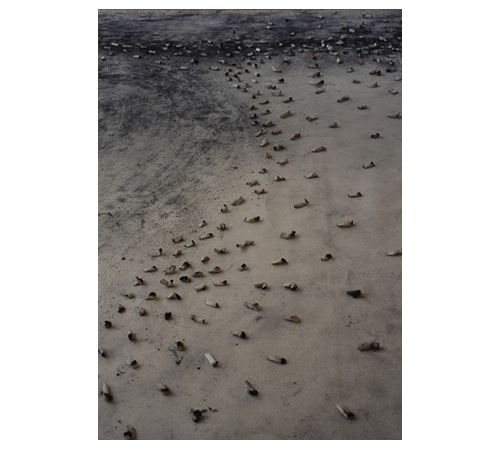|
Eulàlia Valldosera Lateral. Sèrie: El melic del món. Fotografies #12 (Lateral. Series: The navel of the World. Photographs 12), 1990-1991 |
| Photograph |
| 100 x 70 cm |
 |
| Forming an essential part of her earliest works, The Navel of the World, The Belly of the Earth, is, in many ways, the fundamental genesis of Eulàlia Valldosera’s oeuvre. Conceived during her stay in the Netherlands, where she kept up an intense interchange of ideas with the artist Ulay, this work announced important avenues of research that were later to be explored in depth by the artist. The starting point for the work is her own body, which forms an intimate cosmogony from which she approaches existence, or the development of processes wedded to paradoxes, such as create-annihilate, volatility-materiality, hygiene-infirmity, silhouette-presence, recurring elements in the work of the artist and already present in The Navel of the World. In approaching The Navel of the World, one should bear in mind its immediate predecessor, the extensive Dyes series in which, after developing artistic and philosophical techniques evocative of their Asian counterparts, Valldosera met her work head-on in a quest to establish a point of origin, as she herself explains: “I needed to relearn how to work, so I committed myself to putting into practice, literally, Kandinsky’s theory of ‘the dot, the line and the plane’, and I started at the beginning, that is to say, with the dot”. In Dyes, the body emerges from a network of dots that appear to suppurate from the surface of the paper, halfway between orifices and wounds, as if they were spectral traces of the body’s energy nodes. A fragmented woman’s body in which the extremities have been rejected as superfluous; leaving us torsos, breasts, abdomens and buttocks. Rejecting all substantial presence (the artist considers, not in vain, this work to be a manifesto against the single object), our interest revolves, then, around the basic activities of the body itself, such as eating, smoking or sleeping, or residues of activities such as cigarette butts, or the fluff or rumpled sheets left behind in the bed when someone gets up – “noises of the discourse of reason” as Valldosera defines them. In The Navel of the World, she unfolds, on a huge scale, the threads she exposed in Dyes, now constructed with cigarette butts meticulously placed on the ground, then brushed up by the artist herself, leaving traces – silhouettes, appearances of a female body – her own, fragmented, oversize, on huge canvasses where it will be fixed. The action is recorded on video, while the process of transformation of the floor is documented by photographs. Passing from the static to movement, from the trace to the material, from the unique creative act to the shared and open process, to mutability, dyed dots are transmuted into dregs of cigarettes, eloquent manifestations of the smoke that has passed through the body. Now the dots shape it monumentally, dot by dot, leaving intermediary spaces so that whoever is contemplating the image constructs the framework by shaping it, adding the insinuated volume. In The Navel of the World, the body appears as cause and effect of its own residues, emerging from the vestiges of its own fluids. At the same time, the element of process in a body is intensified, as is the protagonism of the body, acquiring physicality in actively including not only the artist, but also the spectator, who is incorporated as a co-substantial actor in the work that he or she observes. One essential factor is the introduction of elements of time and space, which gave the work of Valldosera a sense of prologue upon which her future career would be established as she went on to develop vital work such as the “Bandages” performance, or the installation entitled “The fall”. |
| Rosa Pera |

